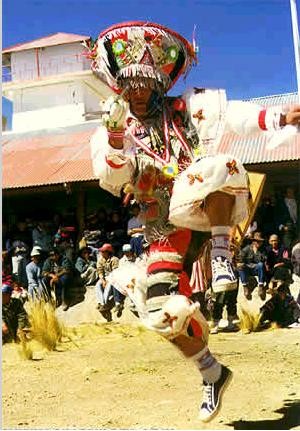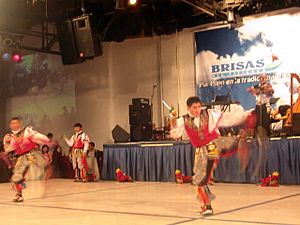Danza de tijeras facts for kids
The Danza de las tijeras (which means "scissors dance" in Spanish) is a special dance from the Andes mountains in Peru. It comes from the ancient Chanka people. In this dance, two or more dancers perform amazing moves. They are joined by musicians playing a violin and a harp. Dancers take turns showing off challenging steps, like dancing on just one foot!
You can mostly see this dance in places like Huancavelica, Ayacucho, Junín, Apurimac, and Lima.
In 2010, UNESCO recognized the Danza de las tijeras as an important part of the world's intangible cultural heritage. This means it's a special tradition worth protecting!
There are different kinds of scissors dances. The main one is a competition dance where two dancers, called "danzaq" or "tusuq," challenge each other. They try to do harder and riskier moves! This exciting contest is known by names like "Atipanakuy." There are also smaller dances, like the "Qolla alva," which is danced at night, and "zapateos" performed during Christmas.
History of the Scissors Dance
The dancers who perform the Danza de las tijeras are connected to ancient priests and healers called "tusuq laykas." These people were very important before the Spanish arrived in Peru.
During the time of the Spanish colony, these dancers faced difficulties. They were sometimes called "supaypa waman," which means "son of the devil" in Quechua. Because of this, they had to hide in the high mountains.
Later, the Spanish allowed them to return, but only if they danced for the Catholic God and saints. This is how the Danza de las tijeras started to be performed at local festivals called "fiestas patronales."
Today, this dance is a mix of magic, religion, and tradition. Through its movements, it tells stories about nature and spirits, like the pachamama (Earth Mother) and hanaccpacha (the sky world).
The famous Peruvian writer José María Arguedas (1911-1969) wrote about the scissors dancers in his books. One of his short stories, La agonía de Rasu Ñiti (1962), even has a scissors dancer as the main character!
What the Scissors Dance Means
To people watching from outside, the scissors dance looks like an amazing show of skill and challenge. It's truly impressive to see the dancers' physical abilities. But for the Andean people, it's much more than just a dance; it's a deep ritual.
The dancers, full of strength and flexibility, perform incredible jumps and moves. They test their skills to the sound of the harp and violin, all while making rhythmic sounds with their special scissors.
The main tool for the dance is a pair of unique scissors. These aren't like regular scissors you use for cutting paper. They are made of two metal plates, about 25 centimeters long. When the two plates are brought together, they make a blunt-ended shape. These special scissors replaced flat stones that were used in ancient times because they made a similar sound. It's considered a big mistake if a dancer drops their scissors while performing!
See also
 In Spanish: Danza de las tijeras para niños
In Spanish: Danza de las tijeras para niños
- Peruvian dances
- Taki Unquy
Images for kids




